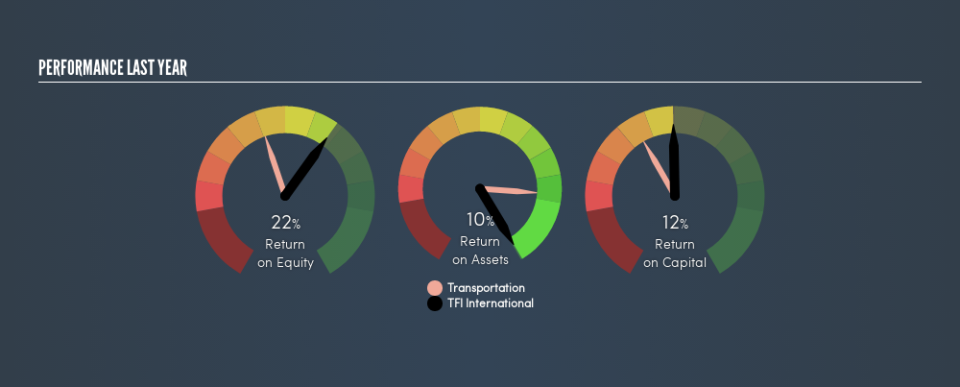Is TFI International Inc.’s (TSE:TFII) Return On Capital Employed Any Good?

Want to participate in a short research study? Help shape the future of investing tools and receive a $20 prize!
Today we’ll look at TFI International Inc. (TSE:TFII) and reflect on its potential as an investment. Specifically, we’re going to calculate its Return On Capital Employed (ROCE), in the hopes of getting some insight into the business.
First of all, we’ll work out how to calculate ROCE. Second, we’ll look at its ROCE compared to similar companies. Then we’ll determine how its current liabilities are affecting its ROCE.
Understanding Return On Capital Employed (ROCE)
ROCE measures the amount of pre-tax profits a company can generate from the capital employed in its business. Generally speaking a higher ROCE is better. Overall, it is a valuable metric that has its flaws. Renowned investment researcher Michael Mauboussin has suggested that a high ROCE can indicate that ‘one dollar invested in the company generates value of more than one dollar’.
So, How Do We Calculate ROCE?
Analysts use this formula to calculate return on capital employed:
Return on Capital Employed = Earnings Before Interest and Tax (EBIT) ÷ (Total Assets – Current Liabilities)
Or for TFI International:
0.12 = CA$254m ÷ (CA$3.9b – CA$654m) (Based on the trailing twelve months to September 2018.)
So, TFI International has an ROCE of 12%.
View our latest analysis for TFI International
Is TFI International’s ROCE Good?
ROCE is commonly used for comparing the performance of similar businesses. Using our data, TFI International’s ROCE appears to be around the 12% average of the Transportation industry. Separate from TFI International’s performance relative to its industry, its ROCE in absolute terms looks satisfactory, and it may be worth researching in more depth.
Our data shows that TFI International currently has an ROCE of 12%, compared to its ROCE of 8.4% 3 years ago. This makes us wonder if the company is improving.
When considering ROCE, bear in mind that it reflects the past and does not necessarily predict the future. Companies in cyclical industries can be difficult to understand using ROCE, as returns typically look high during boom times, and low during busts. ROCE is, after all, simply a snap shot of a single year. What happens in the future is pretty important for investors, so we have prepared a free report on analyst forecasts for TFI International.
Do TFI International’s Current Liabilities Skew Its ROCE?
Current liabilities are short term bills and invoices that need to be paid in 12 months or less. Due to the way the ROCE equation works, having large bills due in the near term can make it look as though a company has less capital employed, and thus a higher ROCE than usual. To check the impact of this, we calculate if a company has high current liabilities relative to its total assets.
TFI International has total assets of CA$3.9b and current liabilities of CA$654m. As a result, its current liabilities are equal to approximately 17% of its total assets. Low current liabilities are not boosting the ROCE too much.
The Bottom Line On TFI International’s ROCE
Overall, TFI International has a decent ROCE and could be worthy of further research. But note: TFI International may not be the best stock to buy. So take a peek at this free list of interesting companies with strong recent earnings growth (and a P/E ratio below 20).
If you are like me, then you will not want to miss this free list of growing companies that insiders are buying.
We aim to bring you long-term focused research analysis driven by fundamental data. Note that our analysis may not factor in the latest price-sensitive company announcements or qualitative material.
If you spot an error that warrants correction, please contact the editor at editorial-team@simplywallst.com. This article by Simply Wall St is general in nature. It does not constitute a recommendation to buy or sell any stock, and does not take account of your objectives, or your financial situation. Simply Wall St has no position in the stocks mentioned. Thank you for reading.

 Yahoo Finance
Yahoo Finance 
